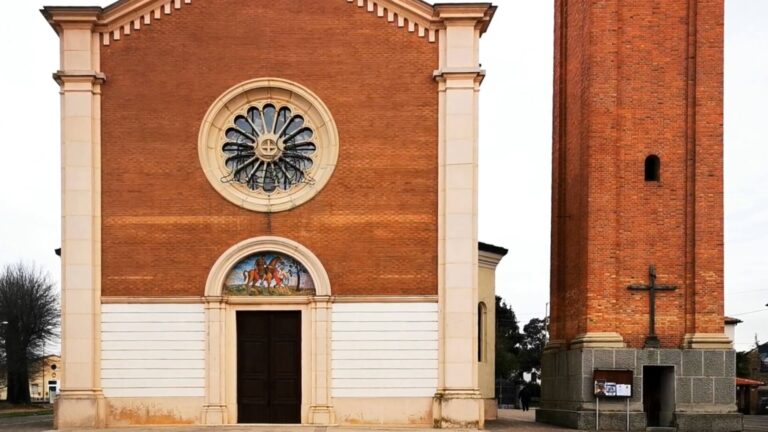ARTISTS’ ROADS
LE VIE DEGLI ARTISTI
watch the videos at the bottom of the page!
VAZZOLA
Vazzola. A Piece of Heaven: Duilio Corompai
We are in Visnà. On the dome above the presbytery is depicted the Glory of Saint Martin, the French saint to whom the church is dedicated.
The space is dominated by clouds that emphasise the curvature of the vault, where the Trinity and angelic hosts appear in monochrome.
The narrative unfolds on one side: putti and cherubim in flight carry the bishop’s crozier and mitre.
The lace-trimmed surplice, the chasuble and the maniple flutter in the air. His outstretched arms and upward gaze trace the ascensional path of Saint Martin.
He is shown as a bishop, not in the more familiar iconography in the act of dividing his cloak with a beggar.
The blue of his chasuble echoes that of the angel with great wings who welcomes him and ushers him into the presence of the Trinity.
Striking in both form and colour are the Four Evangelists depicted on the pendentives.
Their faces are vigorous, earthy. The careful composition clearly defines their positions.
The naturalistic rendering of their gestures as they write in large books, and the vibrant tones of their robes, expand the sense of space, even though the actual volume they inhabit is rather confined.
Close attention is also given to the animals that accompany them:
a lion, calm yet alert,
an ox that meets our gaze,
an eagle, just about to land.
The way the angel beside Saint Matthew leans in gently tells us at what stage in the painter’s artistic journey this work was created.
At the base is an inscription: Duilio Corompai
30 November 1925.
Until 1920, the painter signed as Korompay. He was born in Venice in 1876, but his family was of Hungarian origin.
After the Great War, he Italianised his surname, being of imperial stock was no longer a good passport in post-war Italy.
His father worked for the railways, and the family moved early on to Milan.
At the age of fifteen, he was already enrolled at the Brera Academy.
These were the years when the Impressionists were in Paris and the Milanese academicians were observing them with interest.
They borrowed the use of juxtaposed colour touches, though they did not share the idea that art should speak only of its own time and only in serene settings.
Among the painters who in some way guided him were Gaetano Previati and Giovanni Segantini.
Symbolist painters, attentive to transcendent values.
It was a language Corompai carried with him to Bologna, and then back to Venice, where he took part in the artistic discourse and, from 1905, began exhibiting at the Biennale.
In the angel with elegant gestures and a feminine face, we see again Previati’s great wings.
By now a mature painter, Corompai confidently outlines the figures with a red brush, just like Giotto at the Scrovegni Chapel.
This fresco at Visnà is the first of his tempera murals in sacred art, a field to which he would dedicate himself until 1947, working in the province of Pordenone, the Veneto, and Trentino.
In 1935, he would leave another work at Visnà: a delicate oval of Saint Anne and the Virgin Mary as a Child, where his confident, tactile brushwork gives structure to every detail.
Yet his output was varied, weaving a deep sensitivity for landscape into his portraiture.
Children’s faces, views of the Dolomites, stretches of the vast Venetian plain, the summer light of his garden in Cimpello, and Venice, unusual, and often clothed in night.
MORE EXPERIENCES!
Sugli Altari del Novecento:
- Giovanni Zanzotto nella parrocchiale di Barbisano
- Carlo Donati e Giuseppe Modolo nell’arcipretale di Sernaglia
- Gli altari dell’abbazia di Follina
- Piero Dalle Ceste nella parrocchiale di Refrontolo
MULTIMEDIAL MAP: “ARTISTS’ ROADS – LE VIE DEGLI ARTISTI- EN”!

